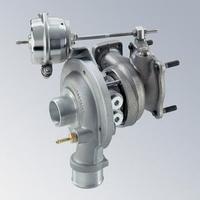More Enjoyable Driving, Lower Consumption: Continental Introduces First Turbocharger for Gasoline Engines
REGENSBURG, Germany, 5 March, 2009 - Continental, the international automotive supplier, is expanding its product portfolio: after just three years of development work, the Powertrain Division's first turbocharger system for internal combustion engines has reached market maturity. The new turbocharger, designed to allow fully-automated assembly and consequently offering production quality and cost advantages, will be installed in a European vehicle platform's gasoline engines. According to Axel-Joachim Maschka, head of the Powertrain Division's Engine Systems Business Unit, "turbocharging gasoline engines is becoming ever more important since it is the only way to solve the inherent conflict of downsizing engines to cut fuel consumption and exhaust emissions without cutting driving performance.
The turbocharger growth market: smaller, supercharged engines reduce CO2
In addition to employing light-weight design, hybrid drives and optimized injection systems, automotive industry development engineers are relying on developing smaller internal combustion engines in order to achieve their ambitious targets of significant reductions in vehicle fuel consumption, and thus of carbon dioxide (CO2) emissions, in the next few years.
Whereas diesel engines have been turbocharged for years, most gasoline engines have so far operated on the induction principle, i.e. the air required to combust the fuel in the cylinders is ducted into the engine from outside. In a turbocharger, a compressor forces the air at high pressure into the combustion chambers. The compressor is driven by a turbine which is turned by the engine's exhaust gas energy. In contrast to the traditional mechanical compressor, the turbocharger makes use of the engine's exhaust gas energy. In this way, significantly greater power can be achieved from engines of considerably smaller cubic capacity and, at the same time, consumption can be reduced. Furthermore, the engine benefits from greater torque or, in other words, more tractive power which drivers regard as a decisive criterion for the vehicle's performance. "This quality leap is comparable with that from the sluggish naturally aspirated diesel engine to the supercharged direct injection diesel engines", comments Udo Schwerdel, who is responsible for development. "The combination of small cubic capacity, direct injection and optimized valve timing allows the engine to operate within ranges which are thermodynamically highly efficient." Drivers will experience these advantages in the form of favorable fuel consumption figures, approaching those of today's diesel engines.
Fully-automated assembly delivers quality and cost advantages
The turbocharger was developed in the record time of just three years at Continental's two sites in Grünstadt/Rheinland-Pfalz and Regensburg/Bayern. The 38 millimeter diameter turbine turns at some 240,000 revolutions per minute, i.e. 4,000 revolutions per second, in the exhaust flow which can reach 1050 degrees. In order to prevent excessive charge pressure at high engine power, the turbocharger is fitted with a wastegate.
This valve, also known as a bypass, ducts the exhaust gases past the turbine if the engine power would otherwise drive the turbine beyond its design limits and cause the turbocharger to operate at excessive speed and the charge pressure to rise too greatly. An overrun air recirculation valve on the compressor side prevents compressed air forcing its way back into the turbocharger's compressor housing and slowing the compressor turbine wheel whenever the exhaust manifold flap is closed, something which could lead to the turbocharger being damaged over time. Continental has used an innovative production method for its turbocharger. All the main components have been designed for fully-automated assembly along a single axis, whereas conventional turbochargers have to be put together in several stages, partly by hand. Fully-automated assembly delivers quality benefits through lower defect rates; it also produces cost benefits and both are important in view of the fact that these turbochargers are to be installed in high-volume model series. In addition, the design concept allows for generously proportioned cooling ducts in the bearing housing which is highly advantageous, especially for small turbochargers for gasoline engine applications at exhaust-gas temperatures of over 1,000°C. Other features of the turbocharger are its sturdy design, reliability and outstanding thermodynamic properties. Thanks to its modular design, the turbocharger is very largely scalable and can be easily adapted for installation in other engine sizes. It was strategic and technical considerations that caused Continental to start with development of this small turbocharger first. Market analyses conducted early on led to the conclusion that almost all engine manufacturers were focusing on developing small supercharged gasoline engines and that there were excellent opportunities for growth in this segment in the next few years.
Series production in Trutnov
Series production of Continental's turbocharger will start in 2011 at the Trutnov plant in the Czech Republic. Production is scheduled to increase rapidly and reach two million components by 2014. The plant, which has a workforce of approx. 400, mainly manufactures high pressure fuel pumps at present.



